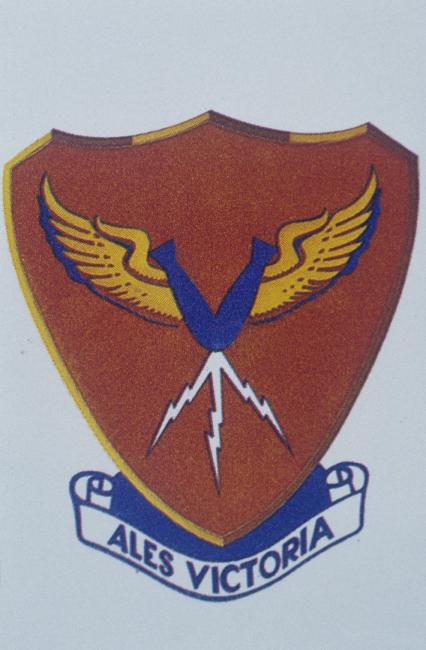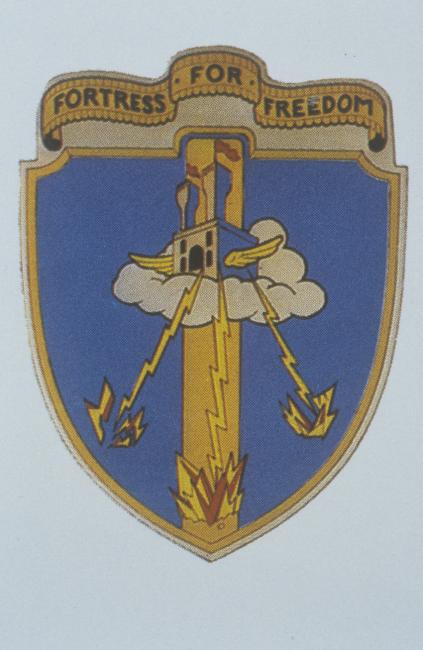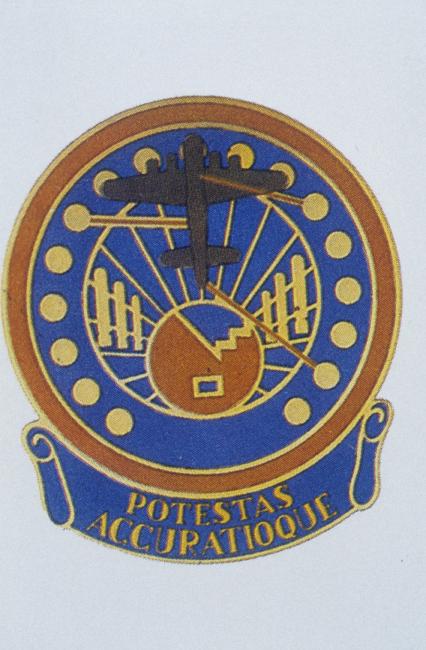VIII Bomber Command 84
17 August 1943![Regensburg, after being bombed by B-17 Flying Fortresses of the 385th Bomb Group, 17 August 1943. Official caption on image: "(O-5-1-385)(17-8-43)(30171-6 3/8 - 24,000)(Regensberg)." Passed for publication 6 Sep 1943. Printed caption on reverse: '#44: View of the target.' Censor no: 282458. On reverse: US Army Press Censor ETO and US Army General Section Press & Censorship Bureau [Stamps].](https://assets.americanairmuseum.com/s3fs-public/freeman/media-413725.jpg)
IWM, Roger Freeman Collection
Object Number - FRE 7714 - Regensburg, after being bombed by B-17 Flying Fortresses of the 385th Bomb Group, 17 August 1943. Official caption on image:...
Official Description
On the first anniversary of US Heavy Bomber operations from UK, 315 B-17’s launch two-pronged attack into Germany, marking deepest penetration of German territory to date. The critical targets are the Messerschmitt complex at Regensburg and the anti friction-bearing factories at Schweinfurt. The bombers unload a 724 ton bomb load, causing extensive damage. Every important building in the complex at Regensburg is damaged, and there are 80 high explosive hits on the 2 main bearing plants at Schweinfurt. 60 US aircraft are lost in fierce air battle that extends to the targets and continues after the bombing. 4th Bomb Wing, after bombing Regensburg, continues to bases in North Africa. During the night of 17-18 August the RAF begins CROSSBOW, massive attacks on German V-weapon sites. About 670 aircraft drop 2,000 tons of bombs on Peenemunde.
Description
The mission flown on 17-Aug-43, the 1st anniversary of the 1st mission flown by the 8th Air Force, is probably the most written about mission of the war. This is the famous Schweinfurt/Regensburg mission on which 60 B-17s are lost. It has been dubbed "Black Tuesday." It is this mission that finally brought home to the air war planners the true vulnerability of the famous B-17 "Flying Fortress" and the critical need for fighter escorts that could accompany the bomber streams to and from targets deep in Germany as "Little Friends."
The need for such a mission was suggested by General Henry Harley "Hap" Arnold, Commanding General of the United States Army Air Forces (USAAF) in March 1943 in accordance with the "Casablanca Directive" (21-Jan-43 cf. CASABLANCA DIRECTIVE in the Missions index for details) and the "Pointblank Directive" (14-Jun-43 cf. POINTBLANK DIRECTIVE in the Missions index for details)
This was one of the most complex missions attempted up to that time in the war and directed deep into Germany to bomb the Messerschmitt production factories at Regensburg and the ball bearing factories at Schweinfurt, Germany. Success would require: close timing; cooperation of the weather in England and across the Continent; precision flying and a goodly measure of luck. While fighter escort was to be a component, it could only accompany the bombers for a short distance into the Continent because of the limited range of the P-47. However, USAAF planners were still very much convinced that the B-17 Flying Fortress and close formation flying would be sufficient to allow the bombers to destroy these targets.
The planned mission was divided into three Air Task Forces. 1st Air Task Force was composed of 146 B-17s, led by Colonel Curtis LeMay of 4th Bomb Wing. This task force was composed of three Combat Wings (CW): 403CW would consist of 62 aircraft: 96BG (21) Lead Group; 388BG (21) Low Group; and 390BG (20) High Group; 401CW would consist of 42 aircraft: 94BG (21) Lead Group; 385BG (21) Low Group; and 402CW consisted of 42 aircraft: 95BG (21) Lead Group; and 100BG (21) Low Group. The Combat Wings would take off at three minute intervals bewteen Comabt Wings with that target being the Messerschmitt factories at Regensburg. The formation would bomb the target and then proceed south to bases in North Africa. It was hoped that this formation would lure the German fighters away from the two Air Task Forces of 1st Bomb Division that would attack the ball bearing works a Schweinfurt.
1st Air Division, led by Brigadier General Robert Williams, would consist of 230 B-17s divided among 2nd Air Task Force, led by Colonel William M. Gross, and 3rd Air Task Force, led by Colonel Howard M. Turner. 2nd Air Task Force would consist of 116 aircraft divided into two Combat Wings (CW): 101CW would consist of 57 B-17s: 91BG (18) Lead Group; 381BG (20) Low Group; and Composite Group A (High Group) consisting of 19 B-17s: 306BG (7); 91BG (6); and 381BG (6). The other Combat Wing (CW) of 2nd Air Task Force was a Composite Wing which would consist of 59 B-17s: 351BG (21) Lead Group; 384BG (18) Low Group; and Composite Group B (High Group) consisting of 20 B-17s: 306BG (9); 305BG (9) and 92BG (2). These CWs were to take off at five minute intervals ten minutes after 1st Air Task Force and attack Schweinfurt.
3rd Air Task Force would consist of 114 B-17s divided into two Combat Wings (CW): 102CW would consist of 61 B-17s: 306BG (21) Lead Group; 92BG (20) Low Group; and 305BG (20) High Group; 103 Provisional CW would consist of 53 B-17s: 379BG (18) Lead Group; 303BG (18) Low Group; and Composite C (High Group) 17 B-17s: 303BG (10), 379BG (6), 384BG (1). These two Air Task Forces were to take off at five minute intervals between CWs, twelve minute intervals between Task Forces and ten minutes after 1st Air Task Force. All Air Task Forces were to fly the same course out of England and into Germany. 1st Air Task Force would proceed to bases in North Africa and the Schweinfurt force would bomb and then return to their bases in England. Everything seemed to be set. 230 B-17s would attack at Schweinfurt and 146 at Regensburg.
On the morning of 17-Aug-43 the weather over the American bases in England was terrible. Ground fog, light drizzle, and completely overcast skies caused the take-off time schedule to get seriously degraded. 1st Air Task Force under Col. LeMay had much training in instrument take-offs and they managed to get in the air and assembled pretty much on schedule. The 230 B-17s of first Bomb Division were not well trained for taking-off in the conditions and they waited an incredible one and one half hours for the fog to lift before they took off. This was disasterous for any element of surprise for the force attacking Schweinfurt and it meant that whatever fighter force engaging LeMay's 1st Air Division would have the opportunity to re-fuel and attack the Schweinfurt Air Task Forces.
The Germans put up every aircraft they could muster to meet the strung out bomber formations and the anti-aircraft fire was horrendous. Of the 230 B-17s despatched to Schweinfurt, 183 managed to hit Schweinfurt, 1 dropped on Frankfurt and 4 attacked targets of opportunity. 36 B-17s Failed to Return crewed by 361 airmen (disposition of these based on MACR records and documented rescues is: 67 KIA, 247 POW, 27 EVD, 20 RTD [rescued by ASR]). One MACR #283 was issued for B-17F #42-5712 "My Prayer" 91BG/324BS which actually returned to England but was DBR from which there were 7 POW 3 RTD. In addition there were 3 KIA and 12 WIA in returning aircraft. Adjusting the totals for the Schweinfurt Groups: 70 KIA, 12 WIA, 254 POW, 27 EVD, 20 RTD (rescued) and 3 RTD OK. The bomber gunners claimed 140-19-36 of the attacking German fighters, but these figures were grossly exaggerated (The combined totals of bomber gunner claims in both the Schweinfurt and Regeansburg attacks was 288-37-99. German records claim that 21 aircraft were shot down by the bomber gunners another 21 were shot down by fighters and 5 were lost on take-off and landing accidents. 16 airmen killed and 9 wounded.
Of the 146 B-17s that were despatched to Regensburg 24 B-17s Failed to Return crewed by 24 airmen (FTR) (disposition of these based on MACR records and confirmed rescues is: 34 KIA, 130 POW, 16 EVD, 20 INT and 40 RTD [rescued by ASR]). One B-17 was DBR but crew OK. In aircraft that managed to return to North African bases 4 KIA and 9 WIA. Adjusting the totals for the Regensburg Groups: 38 KIA, 9 WIA, 130 POW, 16 EVD, 20 INT and 40 RTD. The bomber gunners claimed 140-19-36 of attacking aircraft (grossly exaggerated).
Mission Details
Description: MESSERSCHMITT AIRCRAFT COMPLEX
Aircraft Type: B-17 Flying Fortress
Notes: All aircraft in this element continue on to bases in North Africa.
![Three airmen of the 100th Bomb Group, Lieutenant Kenneth Menzie, Lieutenant Donald Strout and Lieutenant Norman Scott, plan the route they will take during the next mission in their B-17 Flying Fortress (serial number 42-30380). Image stamped on reverse: 'Reviewed and passed U.S. Army 23 Aug 1943 Press Censor E.T.O. U.S.A.' [stamp]'. Passed for publication 23 August 1943 INTLD 16 General Section Press Censorship Bureau '[stamp], 'Associated Press' [stamp] and '280035.' [Censor no.] Printed caption on reve](https://assets.americanairmuseum.com/s3fs-public/styles/max_650x650/public/freeman/media-378743.jpg?itok=oPPVVi6c)
- Unit Hierarchy: Group
- Air Force: Eighth Air Force
- Type Category: Bombardment

- Unit Hierarchy: Group
- Air Force: Eighth Air Force
- Type Category: Bombardment

- Unit Hierarchy: Group
- Air Force: Eighth Air Force
- Type Category: Bombardment

- Unit Hierarchy: Group
- Air Force: Eighth Air Force
- Type Category: Bombardment

- Unit Hierarchy: Group
- Air Force: Eighth Air Force
- Type Category: Bombardment
Mission Statistics
- Tonnage Dropped: 298.75
- People killed in action: 38
- People wounded in action: 9
- People evaded: 16
- Prisoners of war: 130
- People interned: 20
- People returned to duty: 40
- Enemy aircrafts destroyed by bomber: 140
- Enemy aircrafts probably destroyed by bomber: 19
- Enemy aircraft damaged by bomber: 36
- Aircraft sent: 146
- Aircraft effective: 127
- Aircraft missing in action: 24
- Aircraft damaged beyond repair: 1
- Aircraft damaged: 50
Description: BALL BEARING FACTORIES
Aircraft Type: B-17 Flying Fortress
Notes: Anniversary of 1st 8th Air Force mission. Deepest penetration to date. 60 bombers lost. "Black Tuesday." The 91st Bomb Group leads the mission. The 381st Bomb Group suffers the highest losses of all 8th Air Force Bomb Groups on this mission (11 aircraft Missing in Action (MIA))

- Unit Hierarchy: Group
- Air Force: Eighth Air Force
- Type Category: Bombardment

- Unit Hierarchy: Group
- Air Force: Eighth Air Force
- Type Category: Bombardment

- Unit Hierarchy: Group
- Air Force: Eighth Air Force
- Type Category: Bombardment

- Unit Hierarchy: Group
- Air Force: Eighth Air Force
- Type Category: Bombardment

- Unit Hierarchy: Group
- Air Force: Eighth Air Force
- Type Category: Bombardment
Mission Statistics
- Tonnage Dropped: 424.38
- People killed in action: 70
- People wounded in action: 12
- People evaded: 27
- Prisoners of war: 254
- People returned to duty: 20
- Enemy aircrafts destroyed by bomber: 148
- Enemy aircrafts probably destroyed by bomber: 18
- Enemy aircraft damaged by bomber: 63
- Aircraft sent: 230
- Aircraft effective: 188
- Aircraft missing in action: 36
- Aircraft damaged beyond repair: 4
- Aircraft damaged: 118
Connections
See how this entry relates to other items in the archive by exploring the connections below.
People
- Military/Civilian/Mascot: Military
- Nationality: American
- Unit: 381st Bomb Group 533rd Bomb Squadron
- Service Numbers: O-735501
- Highest Rank: First Lieutenant
- Role/Job: Pilot
- Military/Civilian/Mascot: Military
- Nationality: American
- Unit: 381st Bomb Group 535th Bomb Squadron
- Service Numbers: 13103513
- Highest Rank: Staff Sergeant
- Role/Job: Waist Gunner
- Military/Civilian/Mascot: Military
- Nationality: American
- Unit: 381st Bomb Group 534th Bomb Squadron
- Service Numbers: 38107155
- Highest Rank: Staff Sergeant
- Role/Job: Tail Gunner

- Military/Civilian/Mascot: Military
- Nationality: American
- Unit: 91st Bomb Group 324th Bomb Squadron
- Service Numbers: 06981377
- Highest Rank: Staff Sergeant
- Role/Job: waist gunner

- Military/Civilian/Mascot: Military
- Nationality: American
- Unit: 91st Bomb Group 323rd Bomb Squadron
- Service Numbers: 19040558 and O-729796
- Highest Rank: Lieutenant
- Role/Job: Pilot / Co-pilot
Aircraft

- Aircraft Type: B-17 Flying Fortress
- Nicknames: Mizpah - The Bearded Lady aka The Bearded Beauty
- Unit: 91st Bomb Group 322nd Bomb Squadron

- Aircraft Type: B-17 Flying Fortress
- Nicknames: The Eagle's Wrath
- Unit: 91st Bomb Group 323rd Bomb Squadron

- Aircraft Type: B-17 Flying Fortress
- Nicknames: The Sky Wolf, Great Speckled Bird
- Unit: 91st Bomb Group 324th Bomb Squadron

- Aircraft Type: B-17 Flying Fortress
- Nicknames: Little Audrey
- Unit: 306th Bomb Group 384th Bomb Group Base Air Depot 1 368th Bomb Squadron 544th Bomb Squadron

- Aircraft Type: B-17 Flying Fortress
- Nicknames: The Duchess, Sure Stuff
- Unit: 303rd Bomb Group 359th Bomb Squadron
Revisions
Removed some Punctuation in the "Mission Narrative" to aid clarity.
Corrected a typo in the "Detailed description" - "Adjusting" was misspelled.
Lee Cunningham 23-May-2015. Corrected KIA count and RTD count and added bomber gunner claims to statisitcs based on MACR records; "Losses of the 8th & 9th Air Forces", Stan Bishop & John A. Hey MBE; 303BG Mission Report http://www.303rdbg.com/missionreports/060.pdf
Lee Cunningham 23-May-2015. Corrected KIA count and RTD count and added bomber gunner claims to statisitcs based on MACR records; "Losses of the 8th & 9th Air Forces", Stan Bishop & John A. Hey MBE; 303BG Mission Report http://www.303rdbg.com/missionreports/060.pdf
Lee Cunningham 23-May-2015. Correcting typo in Mission Narrative.
Lee Cunningham 23-May-2015. Added Mission Narrative based on 303BG Mission Report http://www.303rdbg.com/missionreports/060.pdf.
Lee Cunningham 19-May-2015. Began the Mission Narrative for the Schweifurt/Regensburg mission. Sources provided upon conclusion of narrative.
Associated Media based on images associated with missions in Freeman, The Mighty Eighth War Diary.
Lee Cunningham, 8th Air Force missions research database / Stan Bishop's 'Losses of the US 8th and 9th Air Forces', the Combat Chronology of the US Army Air Forces and the work of Roger Freeman including the 'Mighty Eighth War Diary'.


![Regensburg, Germany, 17 August 1945 before being bombed by B-17 Flying Fortresses of the 385th Bomb Group. Official caption on image: "(O-8-4-385)(17-8-45)(30250-6 3/8-21,000)(Regensburg Area)." Printed caption on reverse: '#43. View of the target.' Censor no: 282457. On reverse: US Army Press Censor ETO and US Army General Section Press & Censorship Bureau [Stamps].](https://assets.americanairmuseum.com/s3fs-public/styles/max_650x650/public/freeman/media-413588.jpg?itok=e3zGHc8e)
![B-17 Flying Fortresses of the 385th Bomb Group fly in formation over the Alps. Passed for publication 6 Sep 1943. Printed caption on reverse: '#22: Over the Alps.' Censor no: 282441. On reverse: US Army Press Censor ETO and US Army General Section Press & Censorship Bureau [Stamps].](https://assets.americanairmuseum.com/s3fs-public/styles/max_650x650/public/freeman/media-413690.jpg?itok=0BnLGsnQ)
![B-17 Flying Fortresses of the 385th Bomb Group fly in formation over the Alps. Official caption on image: "A-144." Passed for publication 6 Sep 1943. Printed caption on reverse: '#24: Over the Alps.' Censor no: 282443. On reverse: US Army Press Censor ETO and US Army General Section Press & Censorship Bureau [Stamps].](https://assets.americanairmuseum.com/s3fs-public/styles/max_650x650/public/freeman/media-413691.jpg?itok=yFRNi2Et)
![B-17 Flying Fortresses of the 385th Bomb Group fly in formation over the Alps. Official caption on image: "A-147." Passed for publication 6 Sep 1943. Printed caption on reverse: '#23: Over the Alps.' Censor no: 282442. On reverse: US Army Press Censor ETO and US Army General Section Press & Censorship Bureau [Stamps].](https://assets.americanairmuseum.com/s3fs-public/styles/max_650x650/public/freeman/media-413692.jpg?itok=FJCoAYce)
![B-17 Flying Fortresses of the 385th Bomb Group fly in formation. Official caption on image: "A-146." Passed for publication 6 Sep 1943. Printed caption on reverse: '#39: B-17s in formation heading for target.' Censor no: 282470. On reverse: US Army Press Censor ETO and US Army General Section Press & Censorship Bureau [Stamps].](https://assets.americanairmuseum.com/s3fs-public/styles/max_650x650/public/freeman/media-413694.jpg?itok=R6FlsmZt)
![B-17 Flying Fortresses of the 385th Bomb Group fly in formation over the Alps. Official caption on image: "A-105." Passed for publication 6 Sep 1943. Printed caption on reverse: '#25: Over the Alps.' Censor no: 282444. On reverse: US Army Press Censor ETO and US Army General Section Press & Censorship Bureau [Stamps].](https://assets.americanairmuseum.com/s3fs-public/styles/max_650x650/public/freeman/media-413695.jpg?itok=gCzmIi2Q)
![The Italian coast , photographed by a B-17 Flying Fortress of the 385th Bomb Group en route to North Africa. Official caption on image: "A-83." Passed for publication 6 Sep 1943. Printed caption on reverse: '#51: View of Italian Coast. Outgoing to N. Africa.' Censor no: 282429. On reverse: US Army Press Censor ETO and US Army General Section Press & Censorship Bureau [Stamps].](https://assets.americanairmuseum.com/s3fs-public/styles/max_650x650/public/freeman/media-413696.jpg?itok=5_ELRHSN)
![B-17 Flying Fortresses of the 385th Bomb Group in flight over the Alps. Official caption on image: "A-125." Passed for publication 6 Sep 1943. Printed caption on reverse: '#21: Over the Alps.' Censor no: 282440. On reverse: US Army Press Censor ETO and US Army General Section Press & Censorship Bureau [Stamps].](https://assets.americanairmuseum.com/s3fs-public/styles/max_650x650/public/freeman/media-413697.jpg?itok=jhaRS79E)
![B-17 Flying Fortresses of the 385th Bomb Group fly in formation. Official caption on image: "A-130." Passed for publication 6 Sep 1943. Printed caption on reverse: '#35: B17s in formation.' Censor no: 282466. On reverse: US Army Press Censor ETO and US Army General Section Press & Censorship Bureau [Stamps].](https://assets.americanairmuseum.com/s3fs-public/styles/max_650x650/public/freeman/media-413698.jpg?itok=UDCCTttt)
![A B-17 Flying Fortress of the 385th Bomb Group lands in North Africa. Passed for publication 6 Sep 1943. Handwritten caption on reverse: '385.' Printed caption on reverse: '#58. Fortress landing in N. Africa.' Censor no: 282497. On reverse: US Army Press Censor ETO and US Army General Section Press & Censorship Bureau [Stamps].](https://assets.americanairmuseum.com/s3fs-public/styles/max_650x650/public/freeman/media-413702.jpg?itok=SA16tv-h)